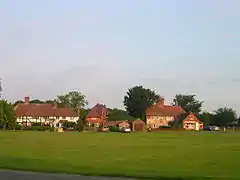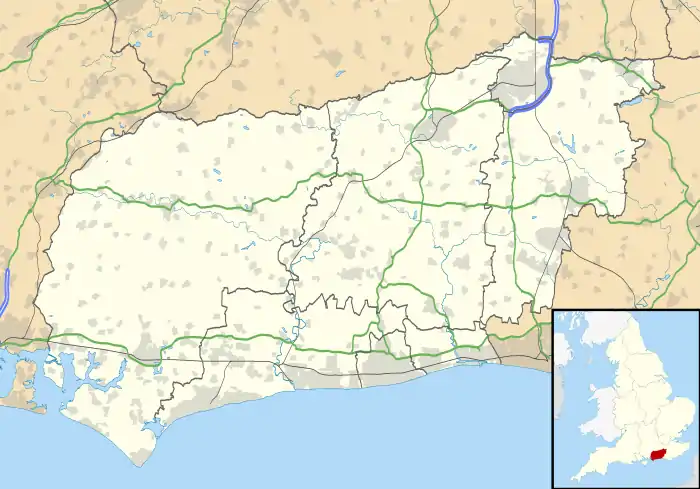Lurgashall
Lurgashall is a village and civil parish in the Chichester district of West Sussex, England, 6.5 km (4 ml) north west of Petworth, just inside the new South Downs National Park. The church of St Laurence, The Noah's Ark pub, the old school and several old houses are built around a village green which contains the village cricket pitch. In the 2001 census the parish covered 21 km² and had 220 households with a total population of 581, of whom 271 were economically active. The population at the 2011 Census was 609.[2]
| Lurgashall | |
|---|---|
 Lurgashall Village Green | |
 Lurgashall Location within West Sussex | |
| Area | 20.97 km2 (8.10 sq mi) [1] |
| Population | 609 2011 Census[2] |
| • Density | 28/km2 (73/sq mi) |
| OS grid reference | SU936271 |
| • London | 40 miles (64 km) NE |
| Civil parish |
|
| District | |
| Shire county | |
| Region | |
| Country | England |
| Sovereign state | United Kingdom |
| Post town | PETWORTH |
| Postcode district | GU28 |
| Dialling code | 01428 |
| Police | Sussex |
| Fire | West Sussex |
| Ambulance | South East Coast |
| UK Parliament | |
| Website | http://www.lurgashall.org/ |
History
The church has had many additions over the years, it still retains some evidence of the original Saxon structure.
The village had become almost extinct in 1100, and finds no mention in the Domesday Book of 1086. After the Norman Conquest, the King gave the Lurgashall area to a Norman family called Alta Rippa, who built a Manor House there in about 1100. The Manor House itself has not survived but the area that the estate occupied is now Park Farm, which gets its name from the Deer Park which the Alta Rippa family established in about 1200. The coming of the Manor revived the village's fortunes and it grew in importance throughout the feudal period.
An account of what it was like to live in the village in the early part of the 20th century is given in the book A view of Edwardian Lurgashall by H. S. Roots. It was re-published in 2000[3] and is based on the memories of a child called Harold who came to the village aged four in 1899. His father was the headmaster of the village school for 10 years and the book is an account of Harold's time growing up in the village and giving accounts of rural life as it was then in what was a fairly isolated village on the northern outskirts of Petworth.
There was at one time a mill which has been transferred to a museum, leaving just the mill pond.[4]
Public house
In 1557 a village inn was built at the side of the Green, probably with funds provided by the Manor. At first it had no name at all, since it was not necessary to distinguish it from any other, but since records began in about 1700, it has been known as The Noah's Ark. It is said to have acquired this unusual name because a pond was once outside the door, which patrons had to cross to refresh themselves, giving the impression of animals crossing into the Ark before the deluge.
With the inn was built a brew house, which continued for over 350 years to brew its own beer, which was delivered to other inns in the district. As well as brewing beer, The Noah's Ark baked bread for the village, giving rise to the jingle:"For well-baked bread and home-brewed ale, you must come to Lurgashale." The inn became the centre of village life – local meetings were held there, it provided refreshments for the Midsummer Fair held each year, it was the local headquarters of the Swing Riots of 1830, and it has refreshed cricket and football teams after their matches.
In 1871, The Noah's Ark was sold to an Arundel brewery and brewing on the premises ceased. In 1906 it was sold again to the Eagle Brewery, for the price of £1,250.00. Fifteen years later it was sold a third time, to Friary, Holroyde and Healy, which owned it until 1990, when the brewers Greene King took over. For over thirty years, the inn has played host to a summer theatrical production. Started in 1967, this venture received a boost when the late Tad Swannell took over the inn in 1970. His participation resulted in an extension of the run from the original one night to three, which has been continued by his successors.
The Rev A. A. Evans wrote in 'A Countryman's Diary':"This was Lurgashall. have been to it several times since and with heightened appreciation... its beauty increases with familiarity, it endures, while the merely catchy and trivial wear away".
Sports and leisure
Lurgashall cricket club plays on the village green, and is often the guest team at the Ebernoe Horn Fair. Some of the sheep's horn trophies won by highest scoring batsmen[5] used to be displayed in the inn. There is a village hall for indoor activities such as bingo, parties and receptions.[6] There is a football pitch to the south-east of the green.

Further reading
- Oakland, Michael A Richer Dust 2007[7]
References
- "2001 Census: West Sussex – Population by Parish" (PDF). West Sussex County Council. Archived from the original (PDF) on 8 June 2011. Retrieved 5 May 2009.
- "Civil parish population 2011". Neighbourhood Statistics. Office for National Statistics. Retrieved 16 October 2015.
- A view of Edwardian Lurgashall, H S Roots, Window Press, Petworth. 2000
- http://www.chichester.gov.uk/CHttpHandler.ashx?id=14709&p=0
- Lurgashall winning teams with the Ebernoe horns
- Village Hall website
- Mystery of name on Lurgashall war memorial is finally solved
